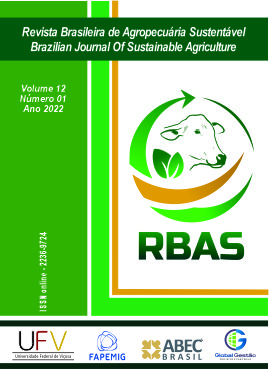PRODUCTION OF THE EDIBLE MUSHROOM PLEUROTUS OSTREATOROSEUS SING WITH LITTERFALL OF EUCALYPTUS GRANDI AND PINUS ELLIOTTII
DOI:
https://doi.org/10.21206/rbas.v12i1.13837Keywords:
Mycelial growth, Biological efficiency, Productivity, Oyster mushroomAbstract
Popularly known as oyster mushroom or shimeiji, Pleurotus spp. (Agaricales, Agaricaceae) is the second most cultivated edible genus in Brazil. Considering the economic importance of its cultivation, this work aimed to evaluate the morphological characteristics, total fresh and dry biomass, as well as the productivity of this mushroom on vegetal substrates. Litterfall of Eucalyptus grandi and Pinus elliottii were used, sawdust of E. grandis, and grass Axonopus compressus. In total, six types of substrates (S1, S2, S3, S4, S5 e S6) were prepared, subdivided among control treatment (CT) and proportions of T1 80%, T2 60%, T3 40%, and T4 20% of the tested substrates. The substrates were inoculated with 18 g of commercial Pleurotus ostreatoroseus spawn, arranged in glass jars, and sealed with a metal lid. After the period of mycelial colonization and basidiomes growth, the mushrooms were collected for analysis. The colonization and cultivation period, morphological characteristics of the mushrooms, and productivity were statistically evaluated. Subsequent to 25 days of mycelial colonization of the substrates, the emergence of primordia occurred between 30 to 49 days, and the total cultivation time was between 38 to 71 days. In total, 254 mushrooms were collected, with a Total Fresh Mass (TFM) of 91.5334 g and Total Dry Mass (TDM) of 33.63588 g. Among the morphological and productivity characteristics, all the substrates tested obtained significant values, with the T1 treatment (80%) of litterfall with both tree species being the most successful. The cultivation based on unprocessed litterfall substrate showed unprecedented promise for the species Pleurotus ostreatoroseus, being suitable for production. Thus, in nutritional biological aspects, these agroindustrial substrates aided in the production of the edible fungal species.
Downloads
Downloads
Published
How to Cite
Issue
Section
License
Copyright (c) 2022 Brazilian Journal of Sustainable Agriculture

This work is licensed under a Creative Commons Attribution-NonCommercial-NoDerivatives 4.0 International License.
1. Proposta de Política para Periódicos de Acesso Livre
Autores que publicam nesta revista concordam com os seguintes termos:
Autores mantém os direitos autorais e concedem à revista o direito de primeira publicação, com o trabalho simultaneamente licenciado sob a Licença Creative Commons Attribution que permite o compartilhamento do trabalho com reconhecimento da autoria e publicação inicial nesta revista.












